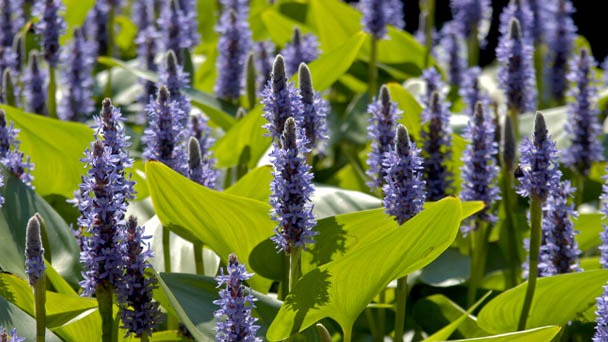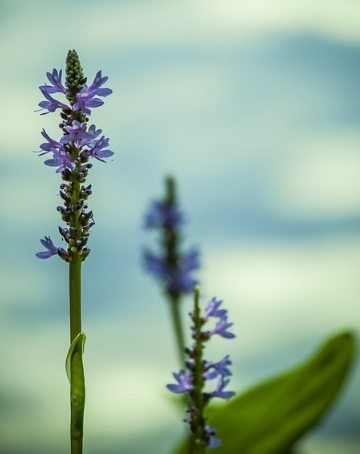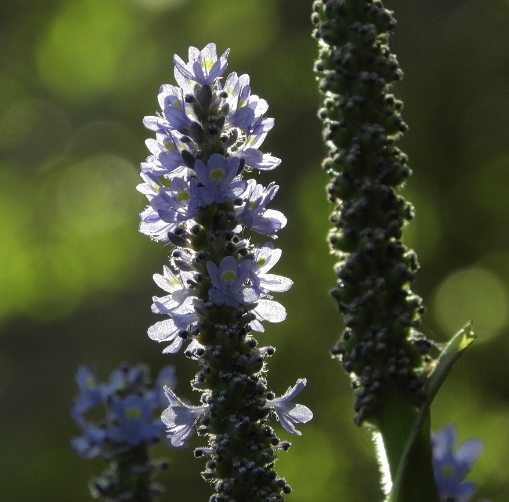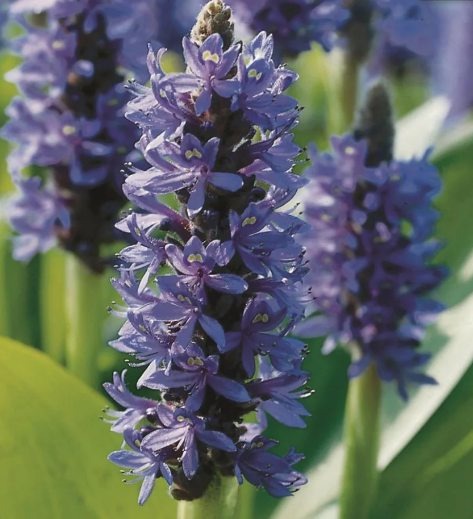How to Grow Pickerel Plant in Your Garden
Written by Ivy
Jan 03 2023

Pickerel weed, also known as Pontedaria cordata, prefers full sun to partial shade and requires little maintenance. Just as attractive as its blooms are its glossy, 10-inch, arrow-shaped leaves, and you can frequently see fish hiding beneath it.
Pickerel rush is a tough plant with simple maintenance that makes a unique addition to riparian areas and along backyard ponds. Pickerel rush is a plant that doesn't require many growing tips, but if you want to avoid it spreading unintentionally, plant it in a submerged pot.

Pickerel Plant Information
| Genus Name | Pontederia cordata |
| Common Name | Pickerel Weed |
| Plant Type | Water Plant |
| Light | Sun |
| Height | 1 to 3 feet |
| Width | 1 to 2 feet |
| Flower Color | Purple |
| Foliage Color | Blue/Green |
| Season Features | Fall Bloom, Summer Bloom |
| Special Features | Attracts Birds, Low Maintenance |
| Zones | 10, 3, 4, 5, 6, 7, 8, 9 |
| Propagation | Division |
| Problem Solvers | Groundcover |
Pros and Cons of Pickerel-weed
Pickerelweed's seeds are eaten by ducks, while the rhizomes and base are eaten by muskrats and nutria. Numerous micro and macro invertebrates can be found in habitats on submerged parts of all aquatic plants. Fish and other wildlife species, such as frogs, use these invertebrates as food. amphibians, reptiles, ducks, etc). After aquatic plants die, their decomposition by bacteria and fungi provides food (called "detritus") for many aquatic invertebrates.
Pickerelweeds are a favorite place for many insects to find food or shelter. At the base of the plant, damselflies and dragonflies have been observed laying eggs. This is why those who want to grow dragonflies in their gardens say pickerelweed is very effective. Pickerelweed is also a favorite of bumblebees (Bombus spp.) and other bee species, Melissodes apicatus and Dufourea novaeangliae, which favor picking up pickerelweed pollen. Sulfur butterflies may forage the plant's nectar, and certain Borer moth larvae including that of the Pickerelweed, White-Tailed Diver, and Cattail moths (Bellura densa, Bellura gortynoides, and Bellura oblique, respectively) feed on its stalks, leaves, and petioles.
How to Grow Pickerel Rush
It's simple to give friends new plant starts. Late winter to early spring is when to divide the rhizomes. Take the plant out of its pot or simply dig it up. Cut the roots into pieces, each with several strong leaves and thick rhizomes, using a clean, sharp soil knife or pruning shears. Replant the new clumps, and they will grow quickly, increasing your pickerel weed supply. Additionally, you can save and dry the plant's seeds to sow inside in flats in the late winter. The bright flowers can take several seasons to appear on seeded plants. Once the seeds have popped up, picking up pickerelweeds only needs constant moisture and strong light. In the spring, plant outdoors.
From spring to fall, perennials can be planted whenever.
Prepare the garden by breaking up the existing soil (use a hoe, spade, or power tiller) to a depth of 12-16" (30-40cm). As soon as the soil is loose and simple to work, add organic material like manure, peat moss, or garden compost. Earthworms and other soil-healthy organisms are encouraged by organic ingredients, which also increase nutrients and drainage. Add a starter fertilizer or all-purpose feed that promotes blooming, such as those with the labels 5-10-5, to plants to give them a boost.
For recommended spacing and the plant's mature height, check the label on the plant. Taller plants should be placed in the foreground and background of the landscape design, while shorter plants should be in the middle. Tap the outside of the pot to loosen it before gently bracing the plant's base, tipping it sideways, and removing the plant from the container. Till the plant easily emerges from the pot, rotate the container and keep tapping to loosen the soil.
Create a hole that is up to twice the size of the root ball and deep enough so that the plant will be planted at the same depth in the ground as the soil in the container. Use your finger to gently rake the roots apart while holding the plant at the top of the root ball. This is especially crucial if the container has been completely filled with dense roots. Plant the tree in the hole.
Gently compact the soil around the roots to fill in any gaps around the root ball. By hand, tamping with the flat side of a small trowel, or even by pressing down with your foot, compact the soil around the plant. The soil that surrounds the planting hole should be level with the soil around it or up to an inch higher than the top of the root ball. In order to establish new plantings well, they should be watered every day for a few weeks.
Prepare in advance for plants that will grow tall and need support cages or stakes. It is best to install cages in the early spring, or at planting time, before the foliage becomes bushy. A trellis, fence, wall, or other structure that permits the plant to grow freely and spread out is necessary for vining plants because they need vertical space to grow.
Finish up with a 2" (5cm) layer of mulch such as shredded bark or compost to make the garden look tidy, reduce weeds, and retain soil moisture.

Pickerel Rush Care
In terms of picking after pickerelweed plants, negligence is the word of the day. Except for complete shade and drought, these fuss-free little rushes can tolerate nearly anything. Pickerels need to be stored in large pots with ample moisture for the roots. Alternatively, you could simply let the wide leaves float outward from the plant while completely submerging the pot. Pickerel rush thrives in rich, heavy soils, making it ideal for ponds. The plant thrives best in loamy soils with pH levels that range from moderately acidic to slightly alkaline. Pickerelweed plants grown in pots thrive in potting soil that is mixed with peat and topsoil of high quality.
Watering
For the first few weeks after planting, new plants need daily watering. The watering schedule may then be changed to every two or three days, depending on the weather and soil type. Expect to water more frequently in sandy settings since clay soils hold moisture for a shorter period of time than sandy soils.
The amount of water that various plants require varies. Some plants prefer to stay on the dry side, while others prefer to have consistent moisture. Check a plant's label to see what it needs specifically.
Ideally water should only be applied to the root zone - an area roughly 6-12" (15-30cm) from the base of the plant, not the entire plant. To maintain the health of your plants and minimize water loss through evaporation, consider investing in a soaker hose. Another effective method of managing water usage is by hand watering with a watering wand equipped with a sprinkler head. In the event that a sprinkler is required due to the size of the garden, try to water early in the day to give the plant foliage time to dry out. Plants can be weakened or damaged by mold and disease, which are encouraged by moist foliage.
Thoroughly soaking the ground up to 8" (20 cm) every few days is better than watering a little bit daily. Deep watering encourages roots to delve deeper into the soil, making for a more resilient plant that can withstand drought.
Use a small trowel or your finger to probe the soil and feel for moisture. If the first 2-4" (5-10cm) of soil is dry, it is time to water.
Fertilizing
When making plant beds for new plants, mix fertilizer into the soil. Early in the spring and again in the middle of the growing season, established plants should be fed. Don't fertilize plants too late in the growing season. This encourages new growth, which early frosts can easily damage.
Fertilizers come in a variety of forms, including granulated, slow-release, liquid feeds, organic, and synthetic. Choose a product with a nutritional balance intended to promote blooming (such as 5-10-5), and decide which application technique is most appropriate for the circumstance.
Reduce the need to fertilize in general by applying a 1-2" (3-5cm) layer of mulch or compost annually. Mulch provides nutrients to the plants as it decomposes while also enhancing the general soil quality.
Pruning
Depending on the flowering habit, remove faded blooms one at a time or wait until the blooming period is finished and cut the entire flower stalk off, all the way to the plant's root system. Old flower stems should be cut off to keep the plant's energy directed toward vigorous growth rather than seed production. To remove harmed or discolored leaves or to maintain plant size, foliage can be pruned freely throughout the season.
After September 1st, refrain from pruning plants. Pruning encourages delicate new growth, which will be easily damaged when the first frosts arrive. Perennial plants need time to prepare for winter, or "harden off". Once plants have died to the ground they are easy to clean up by simply cutting back to about 4" (10cm) above the ground.
The ornamental grasses' flowering plumes and foliage add a lovely touch to the wintertime landscape. In early spring, just before new growth begins, prune the entire plant back to the ground.
Every three to four years, perennial plants should be dug up and divided. This encourages future blooming, promotes healthy new growth, and produces new plants that can be added to the garden or shared with other gardeners.

Pickerelweed Growth, Hardiness & Wintering
Pickerelweed grows vigorously and can reach heights of 1.2 meters (4 feet) and diameters of 0.6 meters (2 feet). These plants like to grow in direct sunlight and will display their satisfaction with their environment by producing showy flowers. Beginning in early summer, flowers continue to bloom continuously through the fall, albeit less vigorously. Pickerelweed can endure harsher climates because of its natural habitat, which extends up into Nova Scotia. It can withstand minimum winter temperatures of -40 to -37°C (-40 to -35°F) and grows in USDA hardiness zones 3 to 10.
Is Pickerelweed Toxic, Poisonous Or Invasive?
The classification of pickerelweed as a "weed" can be considered a misnomer. Pickerelweed is a favorite plant of gardeners and ecologists, in contrast to other undesirable weeds that offer little in the way of aesthetics, pollinator attraction, or utility. Pickerelweed hasn't developed into an invasive or noxious weed despite its quick growth and extensive range. In fact, the United States views it as threatened. state of Kentucky.
Will Koi, Goldfish, & Animals Eat Pickerelweed?
Both animals and people can eat pickerelweed. Many people enjoy gathering the prickly seeds from pickerelweed flowers that are harvested in the fall at the end of the plant's growing season. These seeds are a delicious addition to homemade granola and can be ground into flour, roasted, or eaten raw. Garden dwellers other than horticulturists have discovered pickerelweed to be a tasty snack. The seeds of this aquatic plant are preferred by ducks and muskrats, while deer will eat its leaves voraciously.
Koi and goldfish might eat any seeds that fall into the water of the pond, despite the fact that they are unlikely to eat the plant's rhizomes, stem, or leaves.
Conclusion
Pickerels should be kept in large pots so that the roots can stay moist. The entire pot may also be submerged, leaving only the broad leaves to float around the plant.
For the best effect in your water garden, plant two or three clusters side by side in a big container. Both full sun and partial shade are equally beneficial to this plant. 2 to 12 inches of water should be placed over the plant's roots. During the winter, relocate it to the pool's deepest area.
Latest Updated
- Benefits of Bugleweed - 7 Science-backed Health Benefits
- Bugleweed Dangers & Side Effects - Is It Poisonous?
- How to Plant Evergreen Trees - What You Should Know
- When to Plant Evergreens - Grow Guide for Evergreen Trees
- 12 Wonderful Evergreen Shrubs for Your Garden
- 12 Popular Evergreen Plants with Pictures for Beginners
- When And How To Prune A Lilac Bush Like a Pro
- How to Grow & Care for Lilac Vine (Hardenbergia Violacea)
- Japanese Lilac Tree (Syringa Reticulata) Care & Propagation Guide
- Shumard Oak Pros and Cons - What to Know
Popular Articles
- Winter maintenance of Antirrhinum Majus
- How to Grow Terminalia Mantaly Tree
- How to Grow and Care for Crossostephium Chinense
- How to grow Antirrhinum Majus in spring
- Peristeria Elata (Dove Orchid) Profile: Info & Care Guide
- Underwatered Snake Plant (Sansevieria Trifasciata) - Signs And How To Fix
- How to Care for Brazilian Jasmine Plant (Mandevilla Sanderi)
- How to Grow & Care for Graptopetalum Purple Delight in Summer
- Rosa Chinensis (China Rose): Plant Growing & Care Tips
- How to Care for Baby Sun Rose (Aptenia Cordifolia)